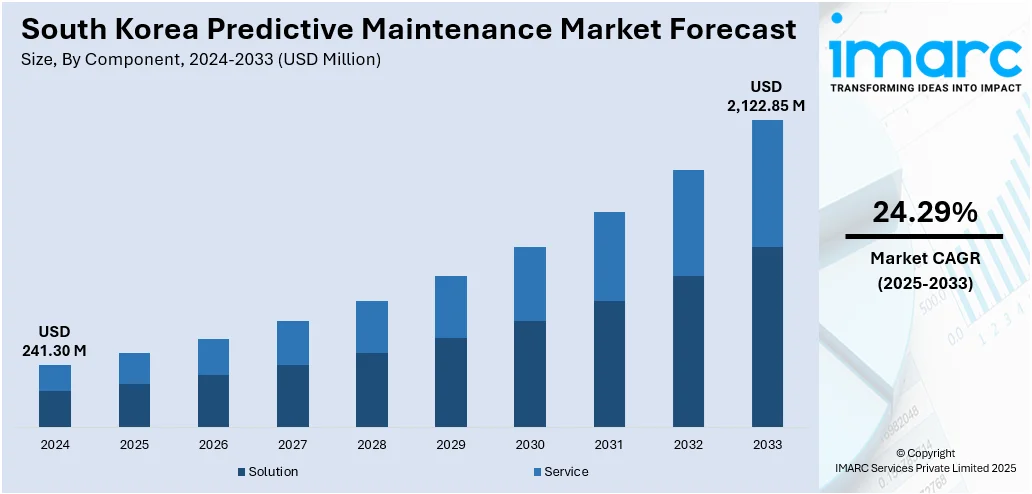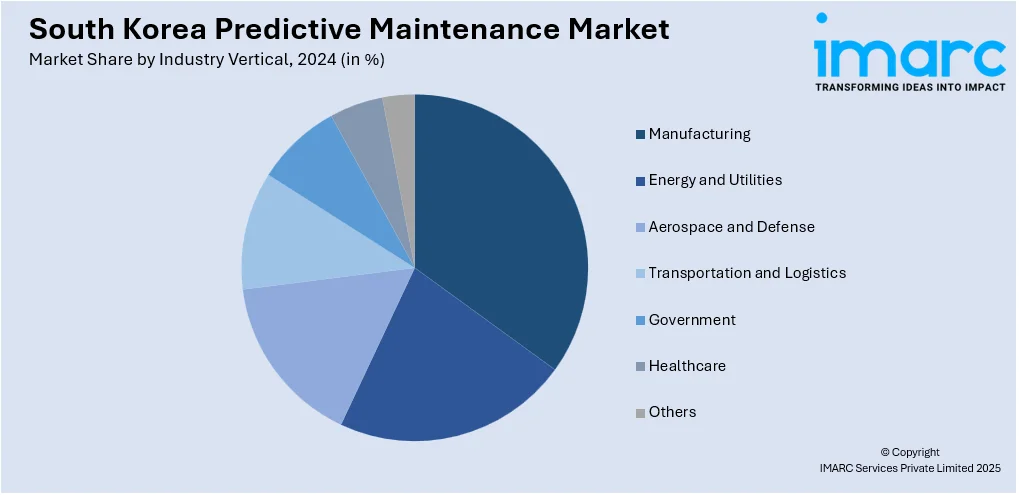
South Korea Predictive Maintenance Market Size, Share, Trends and Forecast by Component, Technique, Deployment Type, Organization Size, Industry Vertical, and Region, 2025-2033
South Korea Predictive Maintenance Market Overview:
The South Korea predictive maintenance market size reached USD 241.30 Million in 2024. Looking forward, IMARC Group expects the market to reach USD 2,122.85 Million by 2033, exhibiting a growth rate (CAGR) of 24.29% during 2025-2033. Rising adoption of Industry 4.0, demand for reduced downtime, government support for smart manufacturing, increasing equipment complexity, and a strong IT infrastructure are some of the factors contributing to South Korea predictive maintenance market share. Local firms prioritize automation to improve efficiency, reduce costs, and boost productivity.
|
Report Attribute
|
Key Statistics
|
|---|---|
|
Base Year
|
2024
|
|
Forecast Years
|
2025-2033
|
|
Historical Years
|
2019-2024
|
| Market Size in 2024 | USD 241.30 Million |
| Market Forecast in 2033 | USD 2,122.85 Million |
| Market Growth Rate 2025-2033 | 24.29% |
South Korea Predictive Maintenance Market Trends:
Proactive Maintenance Shaping Manufacturing
Industrial equipment monitoring in South Korea is becoming more advanced through AI-powered systems that predict failures before they happen. This approach taps into decades of engineering data, enabling machines to flag issues early and avoid downtime. With factories under pressure to become smarter and more cost-efficient, real-time diagnostics and failure prevention have moved from optional to essential. South Korea is pushing hard on digital manufacturing initiatives, and this shift is giving it a competitive edge in asset reliability and operational continuity. This push also positions it strongly in global markets looking for proven predictive solutions. What’s emerging is a serious move toward machine autonomy that minimizes disruption and cuts long-term maintenance spend. These factors are intensifying the South Korea predictive maintenance market growth. For example, in January 2025, FutureMain Co., Ltd., a South Korean industrial AI company, advanced its predictive maintenance technology, ExRBM, which uses proprietary AI and 37 years of engineering data to reduce downtime and maintenance costs. As South Korea pushes smart manufacturing, ExRBM positions the country as a leader in real-time equipment monitoring, proactive failure prevention, and operational efficiency, strengthening its role in the global predictive maintenance market.

To get more information on this market, Request Sample
Flight Data Intelligence Accelerating in Aviation
South Korea is stepping up its use of predictive analytics in airline maintenance and operations. Major carriers are integrating automated flight data monitoring systems capable of processing information within minutes. These tools help detect safety issues faster, support pilot training, and guide aircraft diagnostics with greater accuracy. By applying big data analytics at scale, airlines are reducing manual review time and improving decision-making. This shift reflects a broader focus on preemptive safety measures and operational efficiency in the aviation sector. The technology is becoming a core part of how airlines manage risk and improve performance, reinforcing South Korea’s position as an early adopter of data-driven maintenance in the skies. For instance, in July 2024, GE Aerospace signed a major Safety Insight contract with Korean Air, integrating advanced flight data monitoring systems to boost safety and operational efficiency. The system processes flight data in minutes using big data analytics and automation. Korean Air and Jin Air would use these tools for diagnostics, training, and safety improvements. This move highlights South Korea’s growing adoption of predictive analytics in aviation maintenance and operations.
South Korea Predictive Maintenance Market Segmentation:
IMARC Group provides an analysis of the key trends in each segment of the market, along with forecasts at the country and regional levels for 2025-2033. Our report has categorized the market based on component, technique, deployment type, organization size, and industry vertical.
Component Insights:
- Solution
- Service
The report has provided a detailed breakup and analysis of the market based on the component. This includes solution and service.
Technique Insights:
- Vibration Monitoring
- Electrical Testing
- Oil Analysis
- Ultrasonic Leak Detectors
- Shock Pulse
- Infrared
- Others
The report has provided a detailed breakup and analysis of the market based on the technique. This includes vibration monitoring, electrical testing, oil analysis, ultrasonic leak detectors, shock pulse, infrared, and others.
Deployment Type Insights:
- On-premises
- Cloud-based
The report has provided a detailed breakup and analysis of the market based on the deployment type. This includes on-premises and cloud-based.
Organization Size Insights:
- Large Enterprises
- Small and Medium-sized Enterprises
A detailed breakup and analysis of the market based on the organization size have also been provided in the report. This includes large enterprises and small and medium-sized enterprises.
Industry Vertical Insights:

- Manufacturing
- Energy and Utilities
- Aerospace and Defense
- Transportation and Logistics
- Government
- Healthcare
- Others
A detailed breakup and analysis of the market based on the industry vertical have also been provided in the report. This includes manufacturing, energy and utilities, aerospace and defense, transportation and logistics, government, healthcare, and others.
Regional Insights:
- Seoul Capital Area
- Yeongnam (Southeastern Region)
- Honam (Southwestern Region)
- Hoseo (Central Region)
- Others
The report has also provided a comprehensive analysis of all the major regional markets, which include Seoul Capital Area, Yeongnam (Southeastern Region), Honam (Southwestern Region), Hoseo (Central Region), and others.
Competitive Landscape:
The market research report has also provided a comprehensive analysis of the competitive landscape. Competitive analysis such as market structure, key player positioning, top winning strategies, competitive dashboard, and company evaluation quadrant has been covered in the report. Also, detailed profiles of all major companies have been provided.
South Korea Predictive Maintenance Market News:
- In May 2025, South Korea’s N2 Infotech launched an AI-powered smart maintenance system that predicts elevator component replacement using real-time operational data. By eliminating guesswork and relying on usage-based analytics, the system enhances safety, cuts costs, and streamlines maintenance. Targeting public institutions, where elevator upkeep is legally mandated and budgets are fixed, N2 aims to boost efficiency and reliability across heavily used public infrastructure in the South Korea predictive maintenance market.
South Korea Predictive Maintenance Market Report Coverage:
| Report Features | Details |
|---|---|
| Base Year of the Analysis | 2024 |
| Historical Period | 2019-2024 |
| Forecast Period | 2025-2033 |
| Units | Million USD |
| Scope of the Report |
Exploration of Historical Trends and Market Outlook, Industry Catalysts and Challenges, Segment-Wise Historical and Future Market Assessment:
|
| Components Covered | Solution, Service |
| Techniques Covered | Vibration Monitoring, Electrical Testing, Oil Analysis, Ultrasonic Leak Detectors, Shock Pulse, Infrared, Others |
| Deployments Covered | On-premises, Cloud-based |
| Organization Sizes Covered | Large Enterprises, Small and Medium-sized Enterprises |
| Industry Verticals Covered | Manufacturing, Energy and Utilities, Aerospace and Defense, Transportation and Logistics, Government, Healthcare, Others |
| Regions Covered | Seoul Capital Area, Yeongnam (Southeastern Region), Honam (Southwestern Region), Hoseo (Central Region), Others |
| Customization Scope | 10% Free Customization |
| Post-Sale Analyst Support | 10-12 Weeks |
| Delivery Format | PDF and Excel through Email (We can also provide the editable version of the report in PPT/Word format on special request) |
Key Questions Answered in This Report:
- How has the South Korea predictive maintenance market performed so far and how will it perform in the coming years?
- What is the breakup of the South Korea predictive maintenance market on the basis of component?
- What is the breakup of the South Korea predictive maintenance market on the basis of technique?
- What is the breakup of the South Korea predictive maintenance market on the basis of deployment type?
- What is the breakup of the South Korea predictive maintenance market on the basis of organization size?
- What is the breakup of the South Korea predictive maintenance market on the basis of industry vertical?
- What is the breakup of the South Korea predictive maintenance market on the basis of region?
- What are the various stages in the value chain of the South Korea predictive maintenance market?
- What are the key driving factors and challenges in the South Korea predictive maintenance market?
- What is the structure of the South Korea predictive maintenance market and who are the key players?
- What is the degree of competition in the South Korea predictive maintenance market?
Key Benefits for Stakeholders:
- IMARC’s industry report offers a comprehensive quantitative analysis of various market segments, historical and current market trends, market forecasts, and dynamics of the South Korea predictive maintenance market from 2019-2033.
- The research report provides the latest information on the market drivers, challenges, and opportunities in the South Korea predictive maintenance market.
- Porter's five forces analysis assist stakeholders in assessing the impact of new entrants, competitive rivalry, supplier power, buyer power, and the threat of substitution. It helps stakeholders to analyze the level of competition within the South Korea predictive maintenance industry and its attractiveness.
- Competitive landscape allows stakeholders to understand their competitive environment and provides an insight into the current positions of key players in the market.
Need more help?
- Speak to our experienced analysts for insights on the current market scenarios.
- Include additional segments and countries to customize the report as per your requirement.
- Gain an unparalleled competitive advantage in your domain by understanding how to utilize the report and positively impacting your operations and revenue.
- For further assistance, please connect with our analysts.
 Request Customization
Request Customization
 Speak to an Analyst
Speak to an Analyst
 Request Brochure
Request Brochure
 Inquire Before Buying
Inquire Before Buying




.webp)




.webp)












